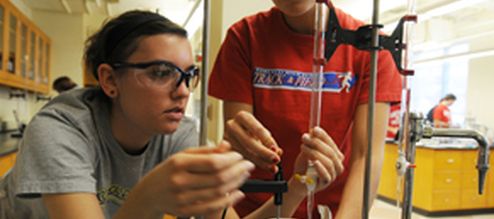Document Type
Article
Publication Date
1986
Publication Source
The Journal of Chemical Physics
Abstract
The one‐ and two‐photon properties of free base porphin, free base porphin dianion, and the 2,4‐substituted diformyl and divinyl analogs of these molecules are studied using a semiempirical SCF‐MO formalism (CNDO‐π‐SCF‐MO‐PSDCI) including extensive single and double configuration interaction. Strongly two‐photon allowed states are predicted to lie in the Soret region as well as in the region between the Soret and visible bands. A number of the two‐photon allowed states in the Soret region are predicted to have two‐photon absorptivities exceeding 100×10−50 cm4 s molecule−1 photon−1. The calculations indicate that the visible (Q) states are well characterized by the four orbital model, whereas the Soret (B) states contain significant contributions from configurations comprised of other orbitals. The inclusion of extensive double configuration interaction significantly reduces the Soret‐visible (B–Q) splitting, increases the Qx–Qy splitting, and yields calculated oscillator strengths for the Qbands in better agreement with experiment than values calculated using single CI alone. The effects of conjugation into the porphyrin macrocycle are predicted to be more significant than inductive effects on macrocycle π orbitals due to substituent polarity. The 〈Qx‖r‖S0〉 and 〈Qy‖r‖S0〉 transition moment vectors are predicted to lie approximately through adjacent pyrrole rings in 2‐ and 4‐monoformyl free base porphin dianions and approximately through adjacent methine bridges in 2,4‐diformyl free base porphin dianion.
Inclusive pages
3901-3915
ISBN/ISSN
0021-9606
Document Version
Published Version
Copyright
Copyright © 1986, American Institute of Physics
Publisher
AIP Publishing
Volume
84
Peer Reviewed
yes
eCommons Citation
Masthay, Mark; Findsen, Leonore A.; Pierce, Brian M.; Bocian, David F.; Lindsey, James S.; and Birge, Robert R., "A Theoretical Investigation of the One– and Two–photon Properties of Porphyrins" (1986). Chemistry Faculty Publications. 79.
https://ecommons.udayton.edu/chm_fac_pub/79




Comments
This article may be downloaded for personal use only. Any other use requires prior permission of the authors and AIP Publishing.
To view the article online, use the DOI provided.
Permission documentation on file.